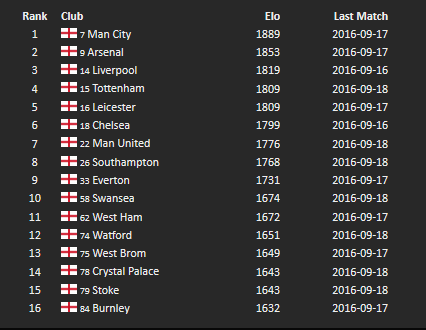As punters, we’re always looking for an angle with which to gain an edge over the bookmakers. Many systems of betting and theories have emerged in recent years, and while some have a certain credence often these are all mouth and no trousers, so to speak.
Another kind of system to be developed with a betting angle is the Elo Ratings method. This was originally devised by the Hungarian chess professional, Arpad Elo, as a measure of skill when ranking his fellow players. It was deemed a success by analysts who then developed it for other sports, and it wasn’t long before the betting community took notice.
So can it be used for making more accurate sports predictions? Its implementation depends on a number of factors, but yes, in short, many mathematically-minded punters have used Elo Ratings to create their own virtual sportsbook; helping them to find value with the bookies.
What are Elo Ratings?
The ratings system is intuitive and common sense: if two teams have a similar rating then they can be expected to put on a tightly contested affair (even accounting for the variance that the beautiful game often delivers). If there is a greater disparity between the two teams in terms of their ratings then a one-sided affair is more likely.

The specific Elo Ratings are calculated by determining the outcome of matches played between rated teams. After each game, the winning team will take some of the points accumulated by the loser, and it is the original ratings of the two sides that determines how many points are awarded to the winning outfit.
This is a simplification of the process, but basically the winning team will earn more points for beating a highly-ranked side than a lowly-ranked opponent, and if a low-ranked team can upset a more established rival then their rewards are obvious.
The beauty of the Elo Ratings system is that it is ‘self-correcting’, which means that, eventually, the best sides will have more points than anybody else. From a football betting perspective, it is really interesting because the league table doesn’t consider where teams are picking up their points from; just how many.
So at early points in the season, where some clubs will have an easier run of fixtures than others, we never quite know how good they are until they meet a quality outfit.
The system also helps to identify underrated teams, who have a habit of beating their peers but then losing to the ‘big boys’. This is a greater reflection of their strength than an orthodox league table.
Calculating Elo Ratings Points
You can, if you are of a mind to, create your own ratings system based on the principles of Elo. But if we want to dive into the system itself, then we need a place to start; and happily, there are websites that are producing the Elo ratings. One such site is clubelo.com, who have bene populating said data for a number of seasons.
Below is the current list of Elo ratings for the 2016/17 Premier League incumbents:
*Note that Middlesbrough, Hull City, Bournemouth and Sunderland aren’t included in this list.*
So let’s run a mock Elo calculation for a relevant fixture. Let’s say that Man City are taking on Swansea.
We know their respective Elo Ratings (1889 and 1674) and to calculate how many points are on the table we must find out 5% of their overall rating. And so, Manchester City are risking 94.5 points and Swansea 83.7 points, which leaves a ‘pot’ of 178.2 points on the table.
So what next?
We wait for the outcome, which can be one of three:
- Manchester City win – they take Swansea’s points (83.7) and their total increases to 1972.7. Swansea’s will decrease to 1590.3.
- Swansea win – they take Man City’s points (94.5) and their total increases to 1768.5. Man City’s total decreases to 1794.5.
- The draw – here the total pot is divided equally between the sides (178.2/2 = 89.1). So Man City’s total becomes 1978.1 and Swansea’s 1763.1.
This is basic overview of the system, and you can see how it creates a ‘fairer’ platform that is respective of the two teams’ abilities, rather than three points for a win and none for a loss.
The Elo system can be broken down even further, and the ratings modified to account for home advantage, goal difference, performances in certain weather conditions, injuries/suspensions etc. You can build your own ratings system quite easily, and this can often be a more accurate way of predicting the outcome of football matches as opposed to just looking at the league table of form guide.
Adopting Elo Ratings in Betting
As we’ve seem, Elo Ratings are a pretty prescriptive way of determining the success of teams in a specific division, and while, typically, it reflects the league table, there are instances where underperforming/underrated teams emerge.
Which leads us nicely to the betting markets….
If a team is currently lying in 15th place in the Premier League, for example, and they are taking on the side in sixth, you might expect the latter to be the bookmaker’s favourite they are priced at 2/1 and 8/13 respectively – fair enough.
But what happens if we do our research and find that they are very closely matched as far as the Elo Ratings are concerned, and in actual fact the odds should be closer to 10/11 for either team? Here we have found ourselves some value, and this shows just why the Elo system is worth persevering with if you are a punter seeking long-term profit.
The system has its limitations, of course. This is, by its very nature, is a long term measure of success (or otherwise), and doesn’t account for immediate, short term actions (a change in manager, injuries to key players etc), and so in that sense we have to be wary of leaning on it too much.
But in terms of finding value bets this season, you won’t find many better methods of identifying teams that are over/under priced. If you fancy having a flutter, take a look at our Bookmaker Reviews here.











